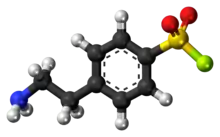AEBSF
AEBSF or 4-(2-aminoethyl)benzenesulfonyl fluoride hydrochloride is a water-soluble, irreversible serine protease inhibitor with a molecular weight of 239.5 Da. It inhibits proteases like chymotrypsin, kallikrein, plasmin, thrombin, and trypsin. The specificity is similar to the inhibitor PMSF, nevertheless AEBSF is more stable at low pH values. Typical usage is 0.1 - 1.0 mM. AEBSF (marketed as Pefabloc SC from the company Pentapharm) was first reported for use in biochemistry in 1993, and came into common use for the inhibition serine proteases and of non-protease enzymes such as acetylhydrolases in the mid 1990s.[2]
 | |
 | |
| Names | |
|---|---|
| Preferred IUPAC name
4-(2-Aminoethyl)benzene-1-sulfonyl fluoride | |
| Other names
Pefabloc SC | |
| Identifiers | |
| |
3D model (JSmol) |
|
| ChEMBL | |
| ChemSpider | |
| DrugBank | |
| MeSH | AEBSF |
PubChem CID |
|
| UNII | |
CompTox Dashboard (EPA) |
|
| |
| |
| Properties | |
| C8H10FNO2S.HCl | |
| Molar mass | 239.69 g/mol |
| 200 mg/mL[1] | |
Except where otherwise noted, data are given for materials in their standard state (at 25 °C [77 °F], 100 kPa).
Infobox references | |
Mechanism of action
AEBSF is targeted to covalently modify the hydroxyl of serine residues, where it causes an additional 183.0354 Da to be added to each modified residue, but other off-target residues such as tyrosine, lysine, histidine, and the protein N-terminal amino group, have also been reported.[3][4] Due to the substantial frequency of modification of these off-target residues in unoptimized protocols, some users recommend not using AEBSF for highly sensitive proteomics applications, and instead recommend using fresh (and comparatively unstable) PMSF.[3] Both AEBSF and PMSF are sulfonyl fluorides and are sulfonylating agents.[5] Sulfonyl fluorides act by reacting with the hydroxy group of the active site serine residue to form a sulfonyl enzyme derivative. This derivative may be stable for long periods of time except at high pH.[6]
Use in cholesterol regulation studies
AEBSF is extensively used in studies aiming to describe cholesterol regulatory genes due to its potent ability to inhibit Site-1-protease (S1P). This serine protease, located in the Golgi apparatus, is responsible for activating the sterol regulatory element-binding proteins (SREBP). By selectively inhibiting S1P, AEBSF can be used to characterize the downstream result of SREBP inhibition and its influence on cholesterol regulation.
See also
References
- "Pefabloc® SC" (PDF). Pentapharm. Retrieved 22 June 2023.
- Dentan, Christine; Tselepis, Alexandros D.; Chapman, M.John; Ninio, Ewa (1996). "Pefabloc, 4-[2-aminoethyl]benzenesulfonyl fluoride, is a new, potent nontoxic and irreversible inhibitor of PAF-degrading acetylhydrolase". Biochimica et Biophysica Acta (BBA) - Lipids and Lipid Metabolism. Elsevier BV. 1299 (3): 353–357. doi:10.1016/0005-2760(95)00226-x. ISSN 0005-2760.
- "Web-Based Discussion Forum - Protease Inhibitor Cocktail". The Association of Biomolecular Resource Facilities (ABRF). Archived from the original on 3 July 2013. Retrieved 22 June 2023.
{{cite web}}: CS1 maint: bot: original URL status unknown (link) - "Accession #: 276 Aminoethylbenzenesulfonylation". Unimod. 2006-10-16. Retrieved 2023-06-21.
- Powers JC, Asgian JL, Ekici OD, James KE (2002). "Irreversible inhibitors of serine, cysteine, and threonine proteases". Chem. Rev. 102 (12): 4735–4736. doi:10.1021/cr010182v. PMID 12475205.
- Gold AM, Fahrney D (1964). "Sulfonyl Fluorides as Inhibitors of Esterases. II. Formation and Reactions of Phenylmethanesulfonyl α-Chymotrypsin". Biochemistry. 3 (6): 783–791. doi:10.1021/bi00894a009. PMID 14211616.